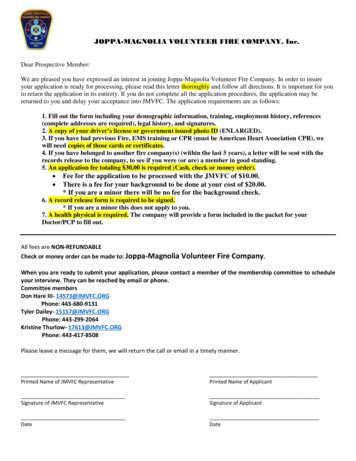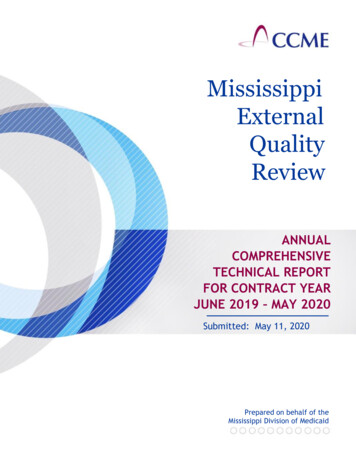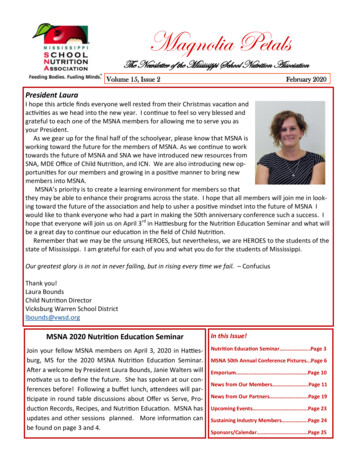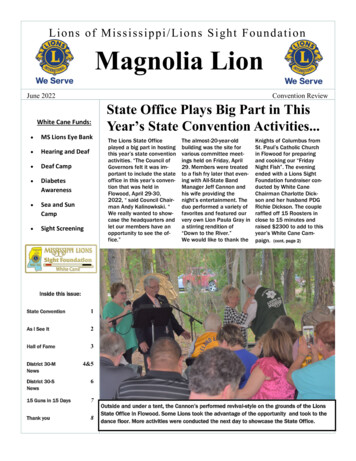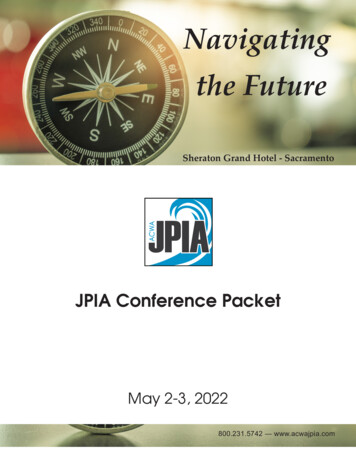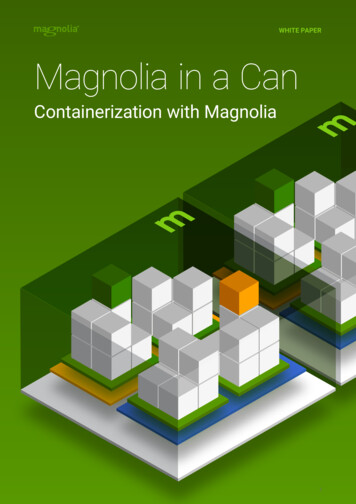
Transcription
WHITE PAPERMagnolia in a CanContainerization with Magnolia1
Magnolia in a CanContents3Magnolia in a Can4Image Ingredients4Decision #1: Choose a Docker base image6Decision #2: Choose a database for the JCR repository7Decision #2.1: Determine whether to run Magnolia and its database in thesame container or in separate containers9Decision #3: Choose an application server9Decision #4: Choose a Java version11Containerizing Your Magnolia Web App11Enable Auto Update12Configure the Magnolia License15Magnolia properties and containerization20JVM settings22Docker container runtime settings23Containerizing Your Content24Capturing content: backup and restore26Synchronizing content28Containerizing Your Light Content31Hacking Magnolia31Making Magnolia work on Alpine36Running Magnolia in memory-limited containers2
Magnolia in a CanMagnolia in a CanScalability, standardization of deployment, operational environments andease of management are all excellent reasons to containerize Magnolia.Magnolia can be containerized and run in tools like Docker, but there isno “one size fits all” way of going about it. Much depends on how youwould like to deploy and run Magnolia and what your CI/CD pipelinelooks like.Since there’s no “one size fits all” solution that could cover all or evenmost situations, we don’t provide a public Docker image for Magnolia tobase your container on.But don’t despair, we’ve outlined the possibilities and choices forcontainerizing Magnolia, their pros and cons and what we consider to be“best practices” in building a Docker container for Magnolia.You’ll learn how you can containerize Magnolia to work in yourenvironment, with your requirements and constraints, and hopefullyavoid some common pitfalls when operating Magnolia.This guide isn’t an introduction to Docker and containers, but we don’tassume you know everything about Magnolia. Features useful to con tainerizing and operating Magnolia are highlighted and explained here.3
Magnolia in a CanImage IngredientsMagnolia needs the following to run in a Docker container: Java Tomcat or another web application container A relational database for the JCR repository (or an embeddeddatabase) Environment setupThese ingredients will go into your Docker image but can be combined indifferent ways, depending on your needs and preferences.So, let’s dive in and start to pick the ingredients for our Docker image.Decision #1: Choose a Docker base imageThere are several options when picking a base image:1. Go for an image already containing one of your basic Magnoliaingredients, such as Tomcat or a relational database to build up yourMagnolia image2. Go distroless: use a Java based distroless image such asgcr.io/distroless/java:11 and add your other Magnolia containeringredients3. Pick an OS image for your base image and add the needed Magnoliaingredients (Java, web application container and database).Picking a Tomcat base image saves you the trouble of adding Java andTomcat to your image and may save you some work down the roadwith updates to the image. If you want to store your JCR repository in arelational database, you’ll have to add it into your image but you can alsouse an embedded database like H2 or Derby to run Magnolia.Picking a database image gets you an underlying OS image to start, butyou have to add Java and Tomcat to your image to run Magnolia.On the other hand, picking an OS image gives you full control over whatyou add into your Magnolia image but also leaves you with the work ofmaintaining and updating what you added.4
Magnolia in a CanGoing distroless forecloses one option for your Magnolia container:running both a separate relational database and web app container (withMagnolia inside of course) in the same Docker container: launchingboth a relational database and the web container with one CMD orENTRYPOINT would mean adding more ingredients into your distrolessbase image, a shell, a relational database and other utilities.RECOMMENDATIONLook over the Magnolia certified stack before picking yourbase image.Pick a well-known image, one that aligns with your skill setand you are familiar with operating.When picking a distro image, pick a distro that is part ofthe Magnolia certified stack.We test Magnolia releases against a range of operating systems: Ubuntu - all currently supported LTS releases SuSE Linux Enterprise Server - all releases with existing (SuSE)general support Fedora - latest two releases Red Hat Enterprise Linux Server For Magnolia 5.x: All releases with full support or maintenancesupport For Magnolia 6.x: RHEL 7 (and later) with full support ormaintenance support CentOS 6 and 7Debian - all currently supported LTS releasesWindows Server 2012 R2Windows 2019 Standard or DatacenterWindows 10Magnolia may run on distro images that are not in the certified stackbut the additional testing that goes into the certified stack may help youavoid problems down the road.5
Magnolia in a CanGOTCHA!Alpine, a popular compact image, won’t run Magnolia outof the box. The system libraries are incompatible withsome of the Java libraries used in Magnolia 6.Alpine can be used as a base image for a Magnolia container but it takesa bit of tweaking, see the “Hacking Docker: making Magnolia work onAlpine” section below.Decision #2: Choose a database for the JCRrepositoryThis is a big decision as the database you choose will likely have a bigimpact on how you operate Magnolia in your container.Again, it’s a good idea to take a look at the Magnolia certified stackbefore picking your database.Here are the databases in the Magnolia certified stack:Embedded databases: H2 1.4.200 and later Derby 10.3.1.4 (included)External databases: MySQL 5.5 and later Oracle 10g Enterprise Edition and later PostgreSQL 9 and laterThe embedded databases - H2 and Derby - don’t require a separatedatabase service to be run in your container. They store their data in filesin the file system, which makes it possible to copy the JCR repositoryfor Magnolia by simply copying files to a new container (more on thislater). Derby and H2 don’t have the sophisticated caching that externaldatabases do and are less performant than external relational databaseswith large JCR repositories.External databases require a separate database service (obviously) andthey are another thing to add into your image or a separate containerand manage when operating.6
Magnolia in a CanHere’s a summary of the pros and cons of each:Embedded databases (H2 and Derby):Pro: No additional database service to run MagnoliaCon: Less performant on large JCR repositoriesCon: Must shut down Magnolia instance to back up JCR repositoryExternal databases (MySQL, Oracle, PostgreSQL):Pro: Better performance, especially on large repositoriesPro: Better tools for monitoring and managementPro: Can use a single database service for multiple Magnolia instancesCon: Another service to containerize and manageDecision #2.1: Determine whether to run Magnoliaand its database in the same container or inseparate containersDocker’s golden rule - one service per container - makes sense inmany situations. It helps break down complex applications into theirconstituent services. It makes setting up an ENTRYPOINT or CMD inyour image easier when managing only one service.But as a whole, Magnolia is a single service. The underlying JCRrepository that Magnolia needs isn’t a separate thing and can’t really beoperated on its own even if the JCR repository is stored in a differentdatabase service.There are different ways to resolve this quandary:Use an embedded database - H2 or Derby - for Magnolia’sJCR repository. No database service is needed, and only onecontainer is required to run Magnolia.The downsides: H2 and Derby may not be as performant with large JCRrepositories and you won’t have an extensive toolbox for monitoring andmanaging the database.RECOMMENDATIONBe aware of your use case. Operating the Magnolia authorinstance versus the Magnolia public instance(s).7
Magnolia in a CanOperating a Magnolia author instance will be different from operatingMagnolia public instances. The JCR repository for a Magnolia authorinstance is valuable: it is the master copy of all content, especiallycontent under development and not yet published. That content shouldbe protected to prevent its loss: the JCR repository of your Magnoliaauthor instance should be bullet-proofed, backed up and monitored.While the author instance will probably be on a private network, thepublic instances will probably be on a public network. Usually there willbe a single author instance, but often there will be several, maybe many,public instances.The JCR repository of a Magnolia public instance isn’t unique: Magnoliapublic instances will each have a copy of all published content in theirrespective JCR repositories. If the repository of a Magnolia publicinstance running in a container becomes corrupted, you can shut itdown and start a new container to replace it.RECOMMENDATIONThe database service and the web container forthe Magnolia author instance should be in separatecontainers.The database service and the web container for Magnoliapublic instances should be in the same container.The public instances are disposable and you may want to add orremove new public instances to meet changing traffic. Managing publicinstances is easier if everything is in a single container, especially if youare automating the management.One container for Magnolia public instances and two containers forauthor instances probably means you will need separate images forauthor instances and public instances. Crafting and maintaining twoimages instead of one is more work, but trying to build an image for bothmay be complex as well.8
Magnolia in a CanDecision #3: Choose an application serverMagnolia runs inside an application server so your image must set upand launch the server.The certified stack offers several application servers to choose from: RECOMMENDATIONApache TomcatWildflyJBoss EAPIBM WebSphere Application ServerIBM WebSphere LibertyChoose an application server that you are familiar withoperating.Again, it is best to pick an application server you are familiar with;if that’s Tomcat (the most commonly used application server), useTomcat. If it is another application server, use that.Other application servers supporting Java web applications may becapable of running Magnolia, but application servers in the certifiedstack are tested against Magnolia releases.Decision #4: Choose a Java versionThis is probably the easiest decision of all.Magnolia runs on Java 8, 9, 10, 11, 12 and 13. Magnolia can be run witha JDK or a JRE, though if you want to use your image in a developmentenvironment, you probably will want to use a JDK.Magnolia runs on both Oracle and OpenJDK Java.Your choice of application server may determine your choice of Javaversion. Tomcat versions may require you use a certain Java version.9
Magnolia in a CanRECOMMENDATIONUse Java 11 or later for better supportrunning in a container: JVM flags likeAlwaysActAsServerClassMachine can improve JVMperformance when running Magnolia in a container.You will probably want to run Magnolia in a container usingthe least amount of resources possible. JVM flags such asAlwaysActAsServerClassMachine are a good starting point for tuninggarbage collection.10
Magnolia in a CanContainerizing Your Magnolia Web AppNow that you have made all the decisions about the ingredients for yourimage, it’s time to containerize your Magnolia web app.BEST PRACTICEMake your Magnolia web application self-starting.By default, your Magnolia web app requires your input when starting up.You will be prompted to: Approve the installation of Magnolia Enter your Magnolia licenseTo start Magnolia without your intervention you can enable auto updatesand configure your license.Enable Auto UpdateWhen Magnolia starts up for the first time or a Magnolia module hasbeen updated, Magnolia will prompt you before proceeding with theinstallation or update.You can avoid this prompt by setting a Magnolia property:magnolia.update.auto trueWhen set to true, Magnolia will proceed with installing or updating itselfwithout prompting.Magnolia properties are a powerful way to control and run Magnolia andcome in handy when containerizing your Magnolia web application. Wewill discuss other Magnolia properties later on.11
Magnolia in a CanConfigure the Magnolia LicenseMagnolia expects to find its license in the JCR repository. You can seeyour Magnolia license by opening the Configuration app and navigatingto /modules/enterprise/license.If Magnolia does not find its license there, Magnolia will prompt you toenter the license during start-up.There are several options for adding your Magnolia license: Bundling the license in the Magnolia web app: create a Mavenmodule that sets the license when it is loaded. Setting the license from the container environment: use theConfiguration Injection module to add your license at runtime. Building a custom Magnolia Java module: a custom module canretrieve and set the license when Magnolia starts.Each of the above options has pluses and minuses:Bundling the license in the Magnolia web appBundling your license into your Magnolia web app puts an expirationdate on your web app. When the Magnolia license expires, the Magnoliaweb app will start but some features will be disabled. Including theMagnolia web app in your Docker image means your Docker image hasan expiration date as well.This is typically not an issue, because chances are that you will updatethe Magnolia web app before the license expires, so including anupdated license won’t be a lot of extra work.However, bundling the license in a module and including it in yourMagnolia web app could be considered a security risk. Your licensecould be recovered from the Magnolia WAR file, your source code, orDocker image.To protect your Magnolia license, make sure that your artifact andsource code repositories as well as your Docker artifacts are secure.12
Magnolia in a CanSetting the license from the container environmentYou can’t set the Magnolia license through Magnolia properties outof-the-box, but you can use the Configuration Injection module fromMagnolia’s Incubator. This module allows you to set the Magnolia licensefrom a Magnolia property when Magnolia starts up. This approachallows you to set the license using a Docker ENV variable when startingyour container decoupling the license from the Magnolia web app.Setting the Magnolia license from the container environment could beconsidered a security risk as well, but it minimizes the number of placesthe Magnolia license can be recovered from. To eliminate this risk, youcould use your container platforms's security features, for example bypassing your license as a Secret.Building a custom Magnolia Java moduleDon’t like either bundling the license in the Magnolia web app or settingthe license from the container environment? Or do you have additionalrequirements, for example, retrieving your Magnolia license from asecure vault? Then building a custom Magnolia Java module may be thebest option for you.Magnolia Java modules have lots of useful tools like startup tasksand dependency management. This option gives you total freedom toimplement a solution that meets your needs.Building a custom Magnolia Java module requires some knowledge ofJava, Java tools like Maven, and possibly the Content Repository API forJava (a.k.a. JCR), as well as an understanding of how Magnolia is puttogether.13
Magnolia in a CanOf the options above, this is what we recommend:BEST PRACTICESet the license from the container environment using theConfiguration Injection module.The Configuration Injection module introduces the system propertymagnolia.inject.config. It can be used to create a startup task thatsets the Magnolia license at /modules/enterprise/license:magnolia.inject.config :/modules/enterprise/license,owner, email for license ;setProperty:/modules/enterprise/license,key, your Magnolia license key For more information on the Configuration Injection module Configuration Injection.If you prefer to bundle the license in the Magnolia web app you cancreate a Magnolia Java module that automatically loads the license onstartup.Magnolia Java modules are one of the basic ways to customizeand extend Magnolia. They require some Java coding to produce aJava jar file, but in our case the amount of coding is limited. You canalso find a template for a license bundle module here: os/autolicense/browse.For more information on developing Magnolia Java modules, check thefollowing ay/DOCS62/How to create and use a custom Magnolia Maven module for custom Java isplay/DOCS62/Bootstrapping in Maven modules14
Magnolia in a CanMagnolia properties and containerizationMagnolia properties control key aspects of Magnolia when it is running.Above we mentioned the Magnolia property magnolia.update.auto,but there are many other Magnolia properties you may want to use inyour Docker image.Magnolia properties can control: Whether Magnolia runs as an author instance or a public instanceThe configuration of the JCR repositoriesDatabase connectionFile system locations for: ResourcesLight modulesMagnolia publication keysTemporary filesMagnolia properties can be set in property files included in yourMagnolia web application but you can override any Magnolia property bysetting a Java property with the same name to a new value.For more on Magnolia property files, see S62/WAR file with multiple agnolia.propertiesfile.Here’s a quick tour of some of the more interesting Magnolia properties:magnolia.home: the granddaddy of all Magnolia properties,magnolia.home is used to set several other Magnolia propertiesspecifying locations like magnolia.resources.dir (location ofMagnolia resources and light content), magnolia.cache.startdir(location of persisted Magnolia cache files), magnolia.upload.tmpdir (destination of files uploaded to Magnolia), magnolia.repositories.home (location of Magnolia’s JCR repository),magnolia.logs.dir (location of Magnolia log files) and magnolia.author.key.location (location of the Magnolia publication key).magnolia.home is used to specify other file system destinations usedby Magnolia under a parent directory.Don’t forget: you can still override individual Magnolia properties defininglocations.15
Magnolia in a Canmagnolia.update.auto: if true, Magnolia doesn't wait for user inputto install or update Magnolia.magnolia.resources.dir: the location of Magnolia light modules.Your Magnolia web application will probably be a combination ofMagnolia Java modules and Magnolia light modules consisting of filesread from the file system.If you want to use light modules in your Magnolia container, you maywant to set magnolia.resources.dir to a Docker volume where youadd files to and share among your Magnolia containers.magnolia.repositories.home: the directory where Magnolia storesJCR repository files and Lucene indices. You may want to persist,add or modify these files for your Magnolia container. magnolia.repositories.home lets you set its location.magnolia.repositories.jackrabbit.config: the location ofthe Jackrabbit JCR configuration file. This file contains databaseconfiguration and file locations.magnolia.logs.dir: the directory where Magnolia log files will bestored.magnolia.bootstrap.dir: the directories where bootstrap contentwill be loaded from.magnolia.bootstrap.authorInstance: one of the mostfundamental Magnolia properties. It controls whether Magnolia will runas an author instance (true) or as a public instance (false).magnolia.develop: improves Javascript generation performancewhen developing, should be set to false for production deployments.You may want to change this based on how the container is used(development versus production containers).magnolia.author.key.location: the location of the private andpublic key used for publication of content from author to public instances.You can also define your own properties and use them in Magnoliaconfiguration files. This includes the Jackrabbit JCR configuration file.16
Magnolia in a CanHere’s an example: DataSources DataSource name "magnolia" param name "driver" value "com.mysql.jdbc.Driver" / param name "url" value "jdbc:mysql://localhost:3306/magnolia" / param name "user" value "root" / param name "password" value "password" / param name "databaseType" value "mysql"/ param name "validationQuery" value "select 1"/ /DataSource /DataSources The properties magnolia.database.url, magnolia.database.user and magnolia.database.password now specify the databaseconnection used by the JCR repository and can be set when you buildyour Docker image or run the container.BEST PRACTICESet key Magnolia properties as Java properties, e.g.-Dmagnolia.update.auto true when running the JVMcontaining Magnolia.There are a couple of ways to do this: In your ENTRYPOINT script If you are using Tomcat, in the CATALINA OPTS environment variableor a setenv.sh scriptHere’s a simple example of a setenv.sh script that initializesCATALINA OPTS:#!/usr/bin/env bash# Container settings - Adjust these default settings according to your needs## JVM settings#17
Magnolia in a Canexport CATALINA OPTS " CATALINA OPTS \-server \-Djava.security.egd file:/dev/./urandom \-Djava.awt.headless true"## JVM memory settings#export CATALINA OPTS " CATALINA OPTS \-Xms JVM XMS \-Xmx JVM XMX"This script defines the Java properties java.security.egd and java.awt.headless as well as the starting and maximum heap size for theJVM. It also enables the Java HotSpot Server VM.The starting and maximum heap sizes are set from environmentvariables when the JVM is started and could be set from ENV variablesyou define for your Docker image.BEST PRACTICEUse ENV and ARG parameters to set important Magnoliaproperties.With so many Magnolia properties, what properties should you setthrough ENV and ARG parameters?It’s hard to give absolute recommendations without qualifications forevery situation, but we recommend thinking about what you want to endup with: one image that can be run in any situation (possible, but you’llprobably end up with a lot of ENV parameters and possibly encounterproblems setting several related Magnolia properties) or several imageswith some key Magnolia properties set as ARGs and other Magnoliaproperties set as ENV properties.18
Magnolia in a CanHere’s a breakdown of how commonly used Magnolia properties mightbe considered as ENV or ARG parameters:ENV parametersMagnolia display properties like magnolia.ui.sticker.environment, magnolia.ui.sticker.color, magnolia.ui.sticker.color.background and magnolia.webapp.These properties can be used to customize the appearance of MagnoliaAdmincentral to help users identify what Magnolia instance they areusing, such as a production, test or dev instance; and the Magnoliainstance, such as author or public instance.ARG parametersMagnolia path properties like magnolia.resources.dir, magnolia.repositories.home, magnolia.bootstrap.dir, magnolia.logs.dir and magnolia.author.key.location.These locations could be set with ENV parameters, but you will probablywant a standard layout for your Magnolia related files and directoriesfor all your Magnolia containers. You can implement a standard filestructure for Magnolia by setting these as ARG parameters.ENV or ARG parametersMagnolia runtime properties like magnolia.bootstrap.authorInstance and magnolia.develop.Magnolia Jackrabbit properties like magnolia.repositories.jackrabbit.config or custom Java properties used in Jackrabbitconfiguration or the magnolia.properties file.These are Magnolia properties that could be set as ARG parametersif you want Docker images with fixed key Magnolia properties or ENVparameters if you want to defer the setting of Magnolia properties todeployment time.19
Magnolia in a CanJVM settingsWhile you are setting your Magnolia properties, don’t forget to setimportant JVM parameters, such as: Starting heap size Maximum heap size Garbage collection settingsBEST PRACTICESet a starting heap size of at least 1 GB, e.g. -Xms1g.Magnolia does a lot of work on starting up; a larger starting heap sizewill minimize start up duration by reducing time for collecting garbage.BEST PRACTICEMonitor memory usage in your Magnolia web app underrealistic conditions to determine the optimal maximumheap size.We can’t give a blanket recommendation for what your maximumheap size should be. It really depends on your Magnolia web app, butmaximum heap sizes from 2 to 4 GB are common. Keep in mind thatbigger is not necessarily better: a very large heap might reduce thenumber of garbage collections but make them longer, interruptingrequest handling.20
Magnolia in a CanBEST PRACTICEUse the -XX: AlwaysActAsServerClassMachine flag ifyour JVM supports it.This sets better garbage collection defaults for a Docker container andhelps you avoid less efficient serial garbage collection.We have touched on the complicated subject of JVM garbage collectionconfiguration.Given different JVMs, different servlet containers, differentMagnolia web apps, it’s hard to go beyond the generalrecommendations we have made (starting and max heap settings, theAlwaysActAsServerClassMachine flag).There can be performance gains by tuning the garbage collectionof your JVM, but there are a couple of caveats: you should test yourchanges in realistic conditions (as we mentioned earlier) and avoidtunnel vision.'Realistic conditions' means reproducing the requests and traffic volumeyou expect or want to serve with a Magnolia instance. 'Tunnel vision'means not ignoring other ways to gain performance. In general, othermeans like implementing a good caching strategy, tuning the Tomcatconnection or looking for performance bottlenecks in your Freemarkertemplates will yield bigger performance wins than tuning your JVMgarbage collection. And don’t forget, if you containerized your Magnoliapublic instance, you could always spin up a new container to handlemore traffic.21
Magnolia in a CanDocker container runtime settingsOne important container setting often overlooked when runningMagnolia is the open files limit.GOTCHA!Magnolia needs a generous open files limit to run.An open files limit of 1024 in a container may not besufficient, especially if you use an embedded database.You have hit the open files limit if you see errors like this:SEVERE: Endpoint ServerSocket[addr 0.0.0.0/0.0.0.0,port 0,localport 80] ignoredexception: java.net.SocketException: Too many open filesjava.net.SocketException: Too many open er SearchManager.java(onEvent:431)17.01.2008 12:52:00Error indexing node.java.io.FileNotFoundException: lia/workspaces/config/index/redo.log (Too many open files)Magnolia usually needs more than 1024 open files to run, so set theopen file limit to something generous when running the Magnoliacontainer:docker run -it --ulimit nofile soft limit : hardlimit your image See: ne/run/#setulimits-in-container---ulimit22
Magnolia in a CanContainerizing Your ContentOnce you have created a container including the Magnolia webapplication and all its ingredients, you may want to think about what isgoing to happen when you launch a container based on your image.Suppose your Magnolia container is going to be used as a Magnoliapublic instance. In that case your instance will have defined web pages,images, resources and other web content.Some of that content - page, area and component templates,customizations of Magnolia apps and configuration and more - may bedefined as 'light' content.Some of the content may be bootstrapped from Magnolia modules inyour Magnolia web application but you may want to load other contentwhen starting Magnolia in a new container.Suppose you have this scenario: a Magnolia author instance and twoMagnolia public instances running in Docker containers built from yourMagnolia image. You want to start a third Magnolia public instance tohandle increased traffic.That new Magnolia public instance must have the same content (webpages, images, resources, etc.) as the other public instances.There are a few ways of initializing content on a new Magnolia publicinstance: Restore the JCR repository on the new instance from a backupSynchronize the content from the Magnolia author instanceImport an export the JCR repositoryAdd bootstrapped content to a Magnolia module included in theMagnolia web appYou can even use a mixture of the above techniques to initialize thecontent on a new Magnolia instance.23
Magnolia in a CanThe above techniques may affect how you build your image. Forexample, you could: Add logic to your CMD or ENTRYPOINT script to retrieve a Magnoliabackup and restore it before starting the web container and Magnolia. Chain together separate scripts in your CMD or ENTRYPOINT, oneto retrieve a backup and restore it, another one to launch the webcontainer and Magnolia. Add logic to your CMD or ENTRYPOINT script to launch contentsynchronization between your new Magnolia public instance and theMagnolia author instance.Capturing content: backup and restoreIf you have a running Magnolia instance with up-to-date content, you canmake a copy of the content and restore it on a new Magnolia instance.Let’s take a closer look at your options for backing up and restoringMagnolia content.Magnolia Backup moduleMagnolia has its own backup and restore tool: https://documentation.ma
Pro: Better performance, especially on large repositories Pro: Better tools for monitoring and management Pro: Can use a single database service for multiple Magnolia instances Con: Another service to containerize and manage Decision #2.1: Determine whether to run Magnolia and its database in the same container or in separate containers


